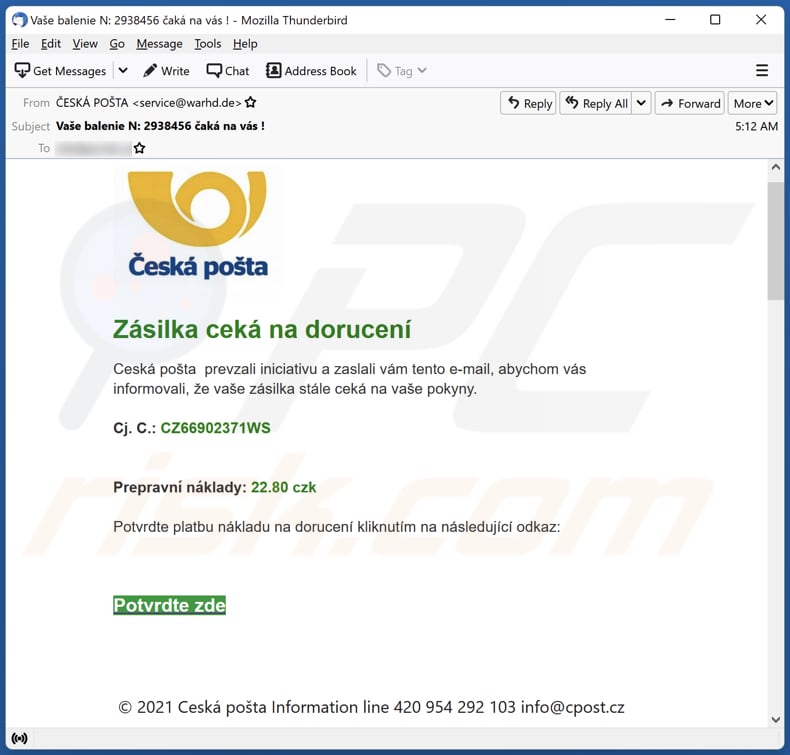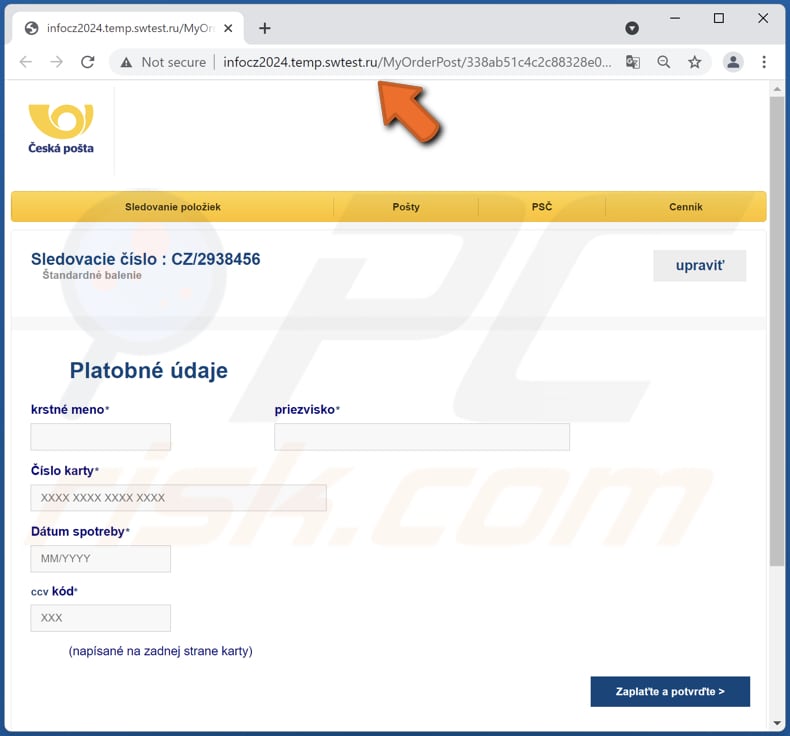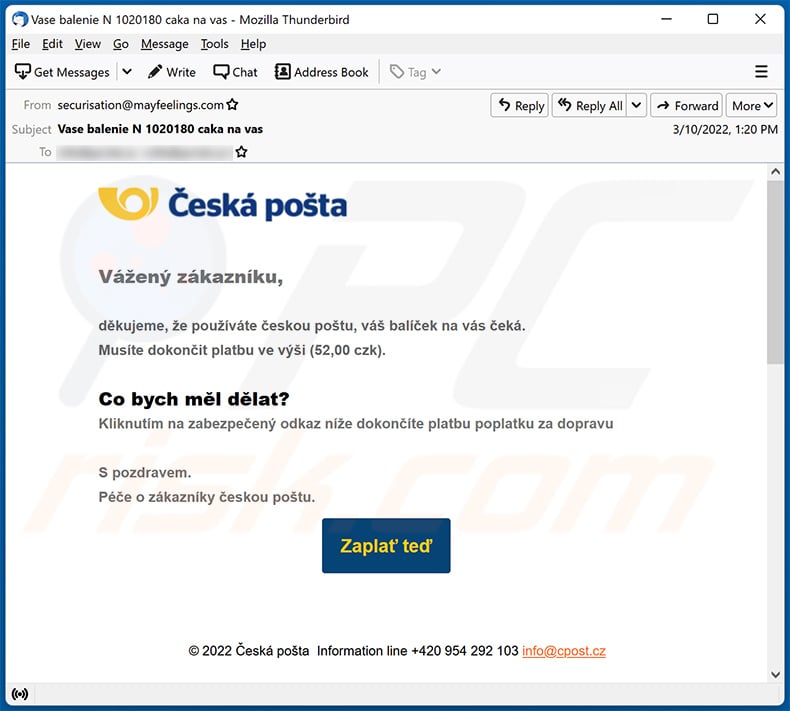How to recognize phishing emails like Česká Pošta email?
Phishing/ScamAlso Known As: Česká Pošta spam
Get free scan and check if your device is infected.
Remove it nowTo use full-featured product, you have to purchase a license for Combo Cleaner. Seven days free trial available. Combo Cleaner is owned and operated by RCS LT, the parent company of PCRisk.com.
What is Česká Pošta email scam?
It is a phishing email that scammers use to trick recipients into opening a deceptive page and providing sensitive information. This email is disguised as a letter from the Czech Post/Česká pošta (the state-owned postal company of the Czech Republic).

Česká Pošta phishing email in detail
This email is disguised as a letter regarding a shipment delivery. Scammers attempt to trick recipients into confirming payment for shipment delivery using the provided website. The website provided in this email asks to provide first and last name and credit card details such as credit card number, expiration date, and CVC code.
| Name | Česká Pošta Email Scam |
| Threat Type | Phishing, Scam, Social Engineering, Fraud |
| Fake Claim | Shipment ready for dispatch |
| Disguise | Letter from the Czech Post/Česká pošta |
| Related Domain | swtest[.]ru |
| Detection Names | CRDF (Malicious), Emsisoft (Phishing), G-Data (Malware), Netcraft (Malicious), Full List Of Detections (VirusTotal) |
| Symptoms | Unauthorized online purchases, changed online account passwords, identity theft, illegal access of the computer. |
| Distribution methods | Deceptive emails, rogue online pop-up ads, search engine poisoning techniques, misspelled domains. |
| Damage | Loss of sensitive private information, monetary loss, identity theft. |
| Malware Removal (Windows) |
To eliminate possible malware infections, scan your computer with legitimate antivirus software. Our security researchers recommend using Combo Cleaner. Download Combo CleanerTo use full-featured product, you have to purchase a license for Combo Cleaner. 7 days free trial available. Combo Cleaner is owned and operated by RCS LT, the parent company of PCRisk.com. |
Phishing emails in general
Typically, phishing emails are used to extract credit card details, login credentials (for example, usernames, passwords), and other sensitive information. They are disguised as letters from legitimate companies (or other entities).
More examples of phishing emails are "Postbank Email Scam", "Wage Bonus/Allowances Email Scam", "Volksbank Email Scam". It is important to know that malware can be delivered via emails too.
How do spam campaigns infect computers?
Emails used to deliver malware contain a website link or an attachment. Threat actors behind such emails seek to trick recipients into infecting their computers via malicious Microsoft Office, PDF documents, executable files, archive files, JavaScript files (or other types of files).
Malicious documents opened with MS Office 2010 or newer do not infect computers unless users enable macros commands (editing/content). These MS Office versions open potentially malicious documents in Protected View mode to prevent computer infections. Older MS Office versions do not have this mode.
How to avoid installation of malware?
Do not open files or links in irrelevant emails received from unknown senders. There is a high chance that emails of this type (their content) will be malicious. Download files and programs using official pages and direct links. Update and (or) activate installed programs using tools provided by their official developers. Never use third-party tools for that - they often contain malware.
Also, have a reliable antivirus or anti-spyware program installed on a computer and run systems scans regularly. If you've already opened malicious attachments, we recommend running a scan with Combo Cleaner Antivirus for Windows to automatically eliminate infiltrated malware.
Text in the email:
Subject: _Vaše balenie N 454584646 čaká na vás !
Ceská pošta
Czech Republic Post | Foreigners.cz Blog
Zásilka ceká na dorucení
Ceská pošta prevzali iniciativu a zaslali vám tento e-mail, abychom vás informovali, že vaše zásilka stále ceká na vaše pokyny.Cj. C.: CZ66902371WS
Prepravní náklady: 22.80 czk
Potvrdte platbu nákladu na dorucení kliknutím na následující odkaz:Potvrdte zde
© 2021 Ceská pošta Information line 420 954 292 103 info@cpost.cz
Prepravní náklady: 22.80 czk
Potvrdte platbu nákladu na dorucení kliknutím na následující odkaz:Potvrdte zde
© 2021 Ceská pošta Information line 420 954 292 103 info@cpost.cz
Fake Česká Pošta website asking for credit card details:

Another example of Česká Pošta-themed spam email:

Text presented within:
Subject: Vase balenie N 1020180 caka na vas
Česká Pošta
Vážený zákazníku,
děkujeme, že používáte českou poštu, váš balíček na vás čeká.
Musíte dokončit platbu ve výši (52,00 czk).Co bych měl dělat?
Kliknutím na zabezpečený odkaz níže dokončíte platbu poplatku za dopravuS pozdravem.
Péče o zákazníky českou poštu.
Zaplať teď© 2022 Česká pošta Information line +420 954 292 103 info@cpost.cz
Instant automatic malware removal:
Manual threat removal might be a lengthy and complicated process that requires advanced IT skills. Combo Cleaner is a professional automatic malware removal tool that is recommended to get rid of malware. Download it by clicking the button below:
DOWNLOAD Combo CleanerBy downloading any software listed on this website you agree to our Privacy Policy and Terms of Use. To use full-featured product, you have to purchase a license for Combo Cleaner. 7 days free trial available. Combo Cleaner is owned and operated by RCS LT, the parent company of PCRisk.com.
Quick menu:
- What is Česká Pošta spam?
- Types of malicious emails.
- How to spot a malicious email?
- What to do if you fell for an email scam?
Types of malicious emails:
![]() Phishing Emails
Phishing Emails
Most commonly, cybercriminals use deceptive emails to trick Internet users into giving away their sensitive private information, for example, login information for various online services, email accounts, or online banking information.
Such attacks are called phishing. In a phishing attack, cybercriminals usually send an email message with some popular service logo (for example, Microsoft, DHL, Amazon, Netflix), create urgency (wrong shipping address, expired password, etc.), and place a link which they hope their potential victims will click on.
After clicking the link presented in such email message, victims are redirected to a fake website that looks identical or extremely similar to the original one. Victims are then asked to enter their password, credit card details, or some other information that gets stolen by cybercriminals.
![]() Emails with Malicious Attachments
Emails with Malicious Attachments
Another popular attack vector is email spam with malicious attachments that infect users' computers with malware. Malicious attachments usually carry trojans that are capable of stealing passwords, banking information, and other sensitive information.
In such attacks, cybercriminals' main goal is to trick their potential victims into opening an infected email attachment. To achieve this goal, email messages usually talk about recently received invoices, faxes, or voice messages.
If a potential victim falls for the lure and opens the attachment, their computers get infected, and cybercriminals can collect a lot of sensitive information.
While it's a more complicated method to steal personal information (spam filters and antivirus programs usually detect such attempts), if successful, cybercriminals can get a much wider array of data and can collect information for a long period of time.
![]() Sextortion Emails
Sextortion Emails
This is a type of phishing. In this case, users receive an email claiming that a cybercriminal could access the webcam of the potential victim and has a video recording of one's masturbation.
To get rid of the video, victims are asked to pay a ransom (usually using Bitcoin or another cryptocurrency). Nevertheless, all of these claims are false - users who receive such emails should ignore and delete them.
How to spot a malicious email?
While cyber criminals try to make their lure emails look trustworthy, here are some things that you should look for when trying to spot a phishing email:
- Check the sender's ("from") email address: Hover your mouse over the "from" address and check if it's legitimate. For example, if you received an email from Microsoft, be sure to check if the email address is @microsoft.com and not something suspicious like @m1crosoft.com, @microsfot.com, @account-security-noreply.com, etc.
- Check for generic greetings: If the greeting in the email is "Dear user", "Dear @youremail.com", "Dear valued customer", this should raise suspiciousness. Most commonly, companies call you by your name. Lack of this information could signal a phishing attempt.
- Check the links in the email: Hover your mouse over the link presented in the email, if the link that appears seems suspicious, don't click it. For example, if you received an email from Microsoft and the link in the email shows that it will go to firebasestorage.googleapis.com/v0... you shouldn't trust it. It's best not to click any links in the emails but to visit the company website that sent you the email in the first place.
- Don't blindly trust email attachments: Most commonly, legitimate companies will ask you to log in to their website and to view any documents there; if you received an email with an attachment, it's a good idea to scan it with an antivirus application. Infected email attachments are a common attack vector used by cybercriminals.
To minimise the risk of opening phishing and malicious emails we recommend using Combo Cleaner Antivirus for Windows.
Example of a spam email:

What to do if you fell for an email scam?
- If you clicked on a link in a phishing email and entered your password - be sure to change your password as soon as possible. Usually, cybercriminals collect stolen credentials and then sell them to other groups that use them for malicious purposes. If you change your password in a timely manner, there's a chance that criminals won't have enough time to do any damage.
- If you entered your credit card information - contact your bank as soon as possible and explain the situation. There's a good chance that you will need to cancel your compromised credit card and get a new one.
- If you see any signs of identity theft - you should immediately contact the Federal Trade Commission. This institution will collect information about your situation and create a personal recovery plan.
- If you opened a malicious attachment - your computer is probably infected, you should scan it with a reputable antivirus application. For this purpose, we recommend using Combo Cleaner Antivirus for Windows.
- Help other Internet users - report phishing emails to Anti-Phishing Working Group, FBI’s Internet Crime Complaint Center, National Fraud Information Center and U.S. Department of Justice.
Frequently Asked Questions (FAQ)
Why did I receive this email?
It is very likely that there are many others who received the same email. Typically, phishing emails are not personal.
I have provided my personal information when tricked by this email, what should I do?
If you have provided credit card details (name, surname, CVC code, expiry date), contact your bank as soon as possible and block the card.
Can a computer get infected via email?
Yes, cybercriminals can use email as a tool to deliver malware. Recipients cause computer infections by opening malicious attachments or files downloaded via received website links.
Will Combo Cleaner remove malware infections that were present in email attachment?
Yes, Combo Cleaner can detect and remove almost all known malware. It is recommended to scan the operating system using a full scan. High-end malware can be hiding deep in the operating system, and running a quick scan might not be enough to detect that malware.
Share:

Tomas Meskauskas
Expert security researcher, professional malware analyst
I am passionate about computer security and technology. I have an experience of over 10 years working in various companies related to computer technical issue solving and Internet security. I have been working as an author and editor for pcrisk.com since 2010. Follow me on Twitter and LinkedIn to stay informed about the latest online security threats.
PCrisk security portal is brought by a company RCS LT.
Joined forces of security researchers help educate computer users about the latest online security threats. More information about the company RCS LT.
Our malware removal guides are free. However, if you want to support us you can send us a donation.
DonatePCrisk security portal is brought by a company RCS LT.
Joined forces of security researchers help educate computer users about the latest online security threats. More information about the company RCS LT.
Our malware removal guides are free. However, if you want to support us you can send us a donation.
Donate
▼ Show Discussion